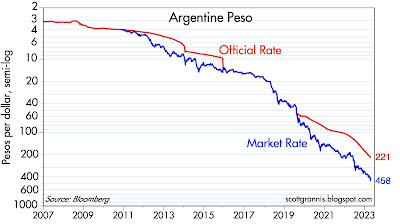Economics
Good news: Argentina nears another devaluation
Argentina is approaching the point at which a devaluation of the peso (i.e., replacing the official exchange rate with a freely accessible market-based…

Argentina is approaching the point at which a devaluation of the peso (i.e., replacing the official exchange rate with a freely accessible market-based rate) is almost inevitable. Paradoxically, this will be good news for Argentina, at least for awhile. Ideally, Argentina should dollarize its economy, but that probably is too much to expect from a regime which is almost hopelessly corrupt.
The above chart traces the inexorable decline of Argentina’s currency since 2007. Since its last iteration at the beginning of 1992, when it traded at 1 to 1 against the dollar, the peso has lost 99.8% of its value. In fact, the peso has been falling for more than a century. Back in 1916, the peso traded at 2 pesos per dollar. Since then, Argentina has changed its currency four times, each time lopping multiple 0’s from its nominal value. If the original peso were still in circulation, it would be trading today at 4,580,000,000,000,000 to the dollar!
A new peso, or at the very least a new currency regime, in which the peso’s value is determined by market forces instead of by government decree, is just around the corner. We know that because government officials are once again denying that there will be a devaluation. Anyone, like me, who has lived in Argentina long enough knows that official denials of an impending devaluation are a sure-fire signal that it is going to happen. We also know it because the current situation—inflation now exceeds 100%, the currency has lost over half of its value in just the past year, and interest rates exceed 80%—cannot go on forever. As a practical matter, since the largest denomination peso bill in circulation ($1000 pesos) is worth only $2.20 dollars, the average person must walk around with a huge roll of bills just to make incidental purchases. (A new $2000 peso bill has been authorized, but that won’t fix the problem.)
The only unknown at this point is whether Argentina will continue to use pesos with a floating (i.e., market-based) exchange rate or whether it will dollarize its economy. The latter would be the best solution, but that’s probably a bridge too far for the current bunch of corrupt politicians, since it would require a massive reduction in government spending. Throughout history, the Argentine government has financed deficit spending by resorting to the printing press. Printing money is a pernicious form of taxation, since anyone who holds onto currency that loses value on a daily basis is effectively paying a tax to the government in the form of lost purchasing power. Corrupt politicians have long known that printing money to pay for spending (which, in turn, helps buy votes) is much easier than cutting spending or raising taxes.
Lest we forget, our own government did precisely this in 2020 and 2021, when some $6 trillion of Covid “emergency” spending was effectively financed by a $6 trillion expansion of the M2 money supply. (I began explaining this way back in July ’21.) That was the proximate cause of the inflation nightmare from which we are now waking up.
Paradoxically, a devaluation would likely be good news for Argentina, at least for awhile. That’s because the current regime—which features an “official” rate of $220 pesos per dollar and a “blue” or parallel rate of $450 per dollar—discourages investment and tourism. If a tourist uses a credit card in Argentina, pesos get translated at the official rate instead of the market rate, which means things cost about twice as much as they would if the tourist used dollars exchanged at the “blue” or parallel rate. Similarly, most foreign exchange which passes through the banking system is processed at the official rate, and that amounts to a severe impediment to foreign investment.
A devaluation would be a boon to Argentine exporters since their export sales would be exchanged at 450 pesos rather than 220. Moreover, it would likely spark a huge inflow of foreign capital since investors would feel more comfortable knowing that they can get a market-based rate for their investment dollars—and it would be much easier to withdraw money in the future if they so chose. Plus, over the years Argentines have stashed hundreds of billions of dollars overseas, and at least part of that would be repatriated following a devaluation.

Argentina Is One of the Most Regulated Countries in the World
In the coming days and weeks, we can expect further, far‐reaching reform proposals that will go through the Argentine congress.
Crypto, Crude, & Crap Stocks Rally As Yield Curve Steepens, Rate-Cut Hopes Soar
Crypto, Crude, & Crap Stocks Rally As Yield Curve Steepens, Rate-Cut Hopes Soar
A weird week of macro data – strong jobless claims but…
Fed Pivot: A Blend of Confidence and Folly
Fed Pivot: Charting a New Course in Economic Strategy Dec 22, 2023 Introduction In the dynamic world of economics, the Federal Reserve, the central bank…




















